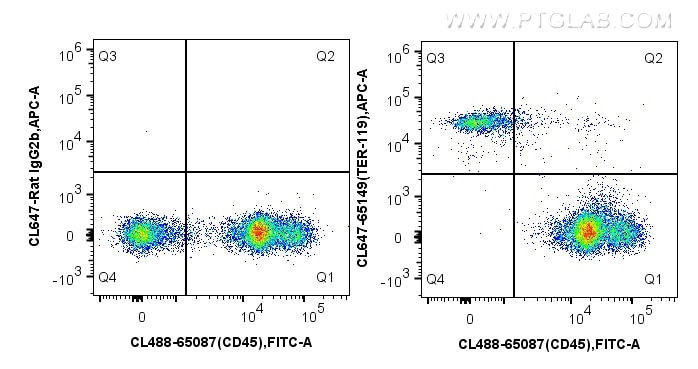TER-119 Monoklonaler Antikörper
TER-119 Monoklonal Antikörper für FC
Wirt / Isotyp
Ratte / IgG2b, kappa
Getestete Reaktivität
Maus
Anwendung
FC
Konjugation
CoraLite® Plus 647 Fluorescent Dye
CloneNo.
TER-119
Kat-Nr. : CL647-65149
Synonyme
Geprüfte Anwendungen
| Erfolgreiche Detektion in FC | Maus-Knochenmarkzellen |
Empfohlene Verdünnung
| Anwendung | Verdünnung |
|---|---|
| This reagent has been tested for flow cytometric analysis. It is recommended that this reagent should be titrated in each testing system to obtain optimal results. | |
| Sample-dependent, check data in validation data gallery | |
Produktinformation
CL647-65149 bindet in FC TER-119 und zeigt Reaktivität mit Maus
| Getestete Reaktivität | Maus |
| Wirt / Isotyp | Ratte / IgG2b, kappa |
| Klonalität | Monoklonal |
| Typ | Antikörper |
| Immunogen | Fetale Leberzellen von Tag 14 aus einer C57BL/6-Maus |
| Vollständiger Name | lymphocyte antigen 76 |
| Gene symbol | TER-119 |
| Gene ID (NCBI) | 104231 |
| Konjugation | CoraLite® Plus 647 Fluorescent Dye |
| Excitation/Emission maxima wavelengths | 654 nm / 674 nm |
| Form | Liquid |
| Reinigungsmethode | Affinitätsreinigung |
| Lagerungspuffer | PBS with 0.09% sodium azide and 0.5% BSA |
| Lagerungsbedingungen | Store at 2-8°C. Avoid exposure to light. Stable for one year after shipment. |
Hintergrundinformationen
TER-119 is a mouse erythroid lineage-specific monoclonal antibody that reacts with erythroid cells at differentiation stages from early proerythroblast to mature erythrocyte, but not with cells showing typical erythroid blast-forming unit (BFU-E) and erythroid colony-forming unit (CFU-E) activities (PMID: 1975515; 10848813). TER-119 recognizes a 52-kDa molecule on erythrocyte membranes (PMID: 10848813). TER-119 antigen is a molecule associated with cell-surface glycophorin A but not with glycophorin A itself (PMID: 10848813).
Protokolle
| PRODUKTSPEZIFISCHE PROTOKOLLE | |
|---|---|
| FC protocol for CL Plus 647 TER-119 antibody CL647-65149 | Download protocol |
| STANDARD-PROTOKOLLE | |
|---|---|
| Klicken Sie hier, um unsere Standardprotokolle anzuzeigen |


